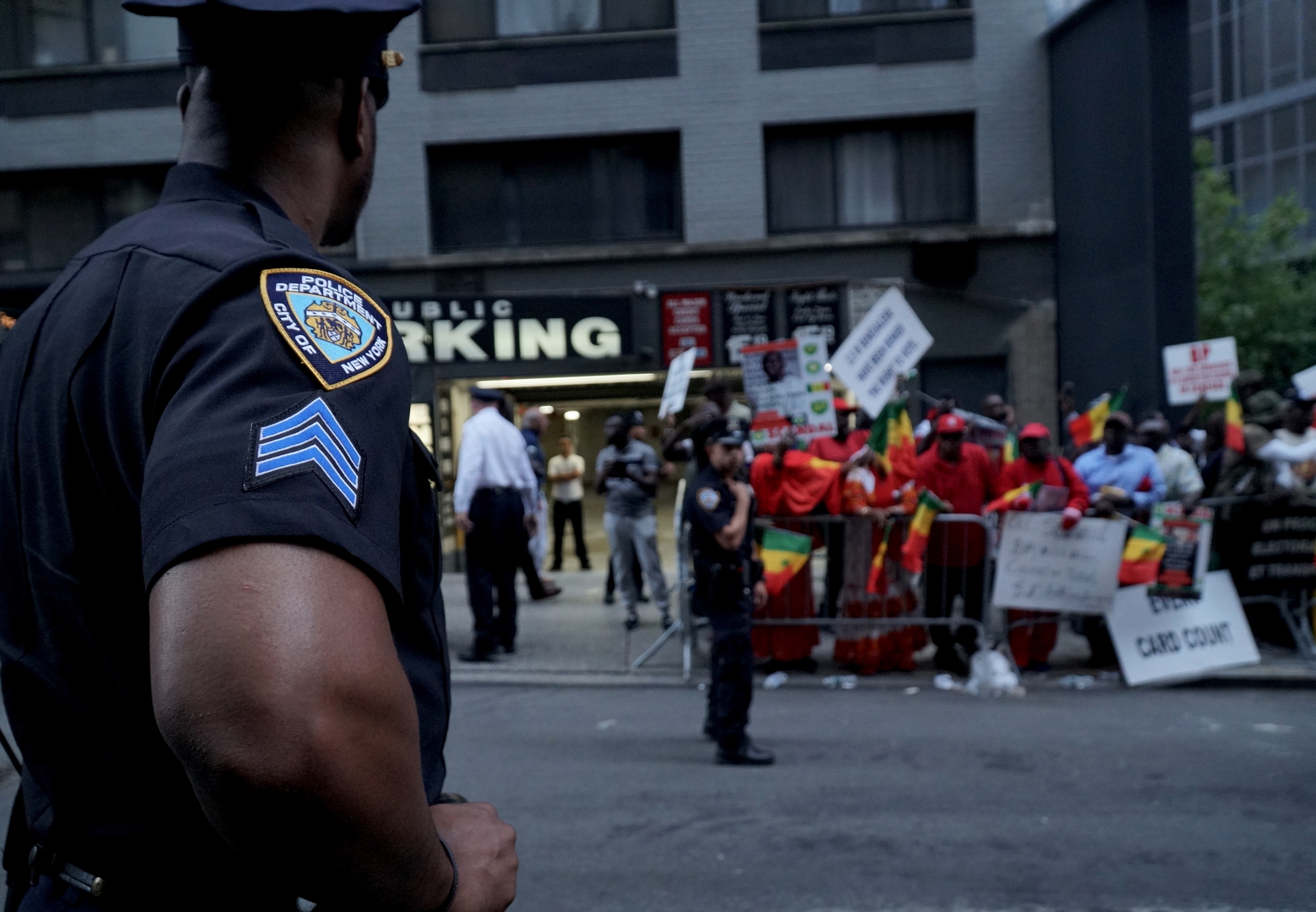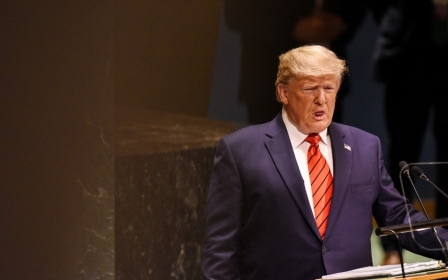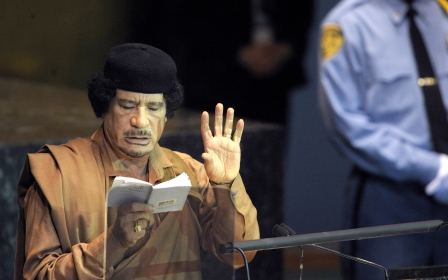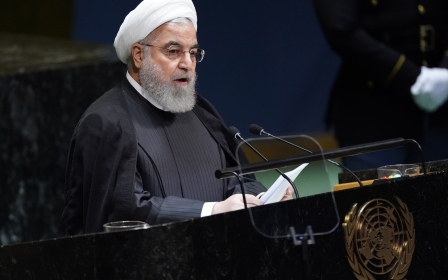Revenge of the suits: How the UN takes over the streets of New York

Abu Syed has seen the UN General Assembly come and go for 16 years now.
His restaurant Joy Curry and Tandoor, on 46th Street between Lexington and Third Avenue, is within walking distance of the UN headquarters and a regular haunt for diplomats and delegations, especially Muslims, looking for halal food.
Over the years he has catered for the Malaysian and Kuwait missions, and so for him, the UN summit that comes to town every year for around ten days is good for business.
But, like for many other New Yorkers, it is a headache too.
The area around the UN headquarters, about two and half blocks away, is in perpetual chaos during this period.
Stay informed with MEE's newsletters
Sign up to get the latest alerts, insights and analysis, starting with Turkey Unpacked
Not only is it tough to move around midtown, but Syed's daily route to his home in Long Island has to change. An hour’s drive can take up to three hours during this week.
Syed's experience is emblematic of the love-hate relationship many New Yorkers have with their proximity to the world's diplomatic elite.
"Having the UN here is good for the city, it brings tourists and business. But having all these leaders here, means we need that security. It's a headache, but we have to compromise, too," the 63-year-old says.
Hotels are full, caterers are brimming and the elites of the business and diplomatic community are around to fraternize with each other, to talk about problems, solutions and spread bluster.
On the other hand, the impact of playing host to thousands of diplomats and journalists and security officials creates a nightmare for many in the city, especially those living or working in the vicinity of the annual jamboree.
On Thursday, Iranian President Hassan Rouhani said Tehran would support an initiative to relocate the UN headquarters from New York, and many here might agree.
For the duration of the event that began this year on 17 September and ends officially on 30 September, entire roads - almost 23 streets - in midtown Manhattan are closed off, or remain at the discretion of the New York Police Department (NYPD) - or more specifically the Secret Service who are in charge of the safety of the 150 dignitaries expected to spend some time at the summit.
Every mode of transport is impacted, from waterways, to air transport to motor vehicles.
Every area through which motorcades carrying the global political elite venture have to be swept for explosives, leaving swathes of midtown in perpetual gridlock.
"Next week, midtown will see some of the slowest traffic in the year. If you do not have to drive, please use alternate modes of transportation," the NYPD said at a press briefing before the summit began.
The New York City administration did not respond to MEE's request for comment on the impact or cost to the city. According to reports, the summit costs the NYPD alone $20m to $30m.
One police officer, who was not authorised to speak to the media, commented at the scale of the all-encompassing security detail: “If something had to happen, it wouldn’t be through the lack of trying.”
The comment, said in jest, is nonetheless accurate.
The city is teeming with Secret Service, FBI agents and NYPD officers. There are barricades for pedestrians and lines of dumpster trucks blocking roadways from would-be suicide car bombs.
Across New York, the lobbies of five star hotels, home to presidents and prime ministers and their often large delegations, turn into airport security checkpoints.
Inside the hotels, seemingly endless networking takes place over cups of black coffee, diet coke or bottles of wine.
Outside, secret agents stand guard, along with chain-smoking bodyguards and diplomats hanging around between meetings.
On street corners in mid-town, protesters - from a single man holding up a placard to hundreds of organised demonstrators - gather every day to express their discontent. A protest against the Iranian government can be two blocks away from one calling for an end to US-led threats of regime change there.
On another street, two sets of protesters, for and against the Senegalese President Macky Sall, stand literally across the street from each other, separated by barricades and under the close stewardship of the NYPD.
With so many journalists - 4,000 reportedly applied for accreditation - there is also incessant politicking and careful PR management.
A Senegalese government official asked MEE to make sure pro-government supporters were not excluded from our coverage.
In the vicinity of the Lotte New York Palace, where Abdel Fattah el-Sisi is staying, small sporadic protests pop up throughout the week, calling for the Egyptian president to step down.
From the hotel itself, curtains shiver or are drawn completely as bodyguards pull out their own cameras to film the protesters, an act of surveillance and intimidation itself.
On the streets emanating from the UN headquarters, from 1st Avenue all the way to 5th Avenue, delegations of men in tailored skinny suits, and some women in pencil skirts, thunder through the busy pavements from meeting to meeting, their blue UN badges swinging adamantly from their necks.
It is a spectacle each time police clear the roads for a motorcade or for a delegation to cross the street; some curious heads peer to see if the men in suits are one of the dictators they have seen on television, others motor on to their next appointment, unperturbed.
With the immense networking and hobnobbing at every turn, it’s that one time of year where the abandoned business cards of government aides are found scattered on the streets and on the floor of hotel toilet cubicles.
Unsurprising, given there are around 600 events and meetings over the course of the two weeks.
But for many New Yorkers, the UN circus coming to town is just part of the order and disorder they have come to accept about living here.
This is a city that in 2017 had 640 protests, or almost two per day, involving in total 647,063 people.
The NYPD did not respond to MEE's request for clarity on the number of protests that have taken place during the summit. It would only say that a permit was not needed to hold a demonstration.
One shop attendant at a gift store on Second Avenue says after 30 years of living in the area she was “used to the protests,” even if they “can be a bit of annoyance at times”. For those living in streets closed off to the general public, an ID card is also mandatory to getting into their homes.
“After all this time, you just zone out each time there is a protest around here,” the shop attendant, who didn’t want to be identified, says with a shy smile.
Another man, working at a laundry on 46th street between First and Second Avenue, said he had been warned about the disruptions this week, but didn't realise the difficulties he would face.
"I have to carry all the laundry from here to the main street, so people can fetch them. Then the delivery guys can't get here on time, because of the traffic, so everything is behind," he tells MEE, without offering a name. "This week is physically taxing," he said with a half-grimace, half-smile.
New Yorkers know this part of the city is best avoided at this time of the year. The rest are on social media using "unga traffic" to complain.
Roberto Sardinos, who works at a florist on 46th street, agreed that the global summit can be a major impediment for business. His street is completely closed off, except to residents or UN diplomats and media.
“We get some work, but during this week, people avoid this area. So we lose passerby traffic. Our doors are open, as you can see, but we are closed," says Sardinos.
“The UN meeting is a lot of hot air. Lots of talking, nothing else,” the 46-year-old says, his forehead creasing into a frown and his hands mimicking a talking head.
The UN General Assembly takes a year to organise.
No sooner after this summit ends on 30 September, the preparations for the next one begin.
Back at Joy's Curry and Tandoor, Syed wants to make it clear that though motorcades and endless changes to the cities' geography during this period are hard, the UN is a symbol of living and working in NYC itself.
The hustle, the bustle; he wouldn't swap it for anything else. Besides, busy times are always good for business.
“The city gives me my bread and butter,” Syed says.
Middle East Eye delivers independent and unrivalled coverage and analysis of the Middle East, North Africa and beyond. To learn more about republishing this content and the associated fees, please fill out this form. More about MEE can be found here.


![Abu Syed [MEE/Azad Essa]](/sites/default/files/abu_.jpg)
![Up to 23 roads are impacted by the security detail related to the UN General Assembly [MEE/Azad Essa]](/sites/default/files/un5.jpg)
![There are marches of every type and kind during the UN General Assembly [MEE/Azad Essa]](/sites/default/files/un1.jpg)
![Thousands of journalists descend on to NYC to cover the UN General Assembly [MEE/Azad Essa]](/sites/default/files/un2.jpg)


